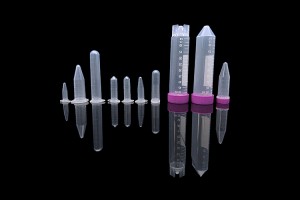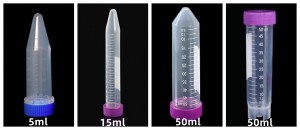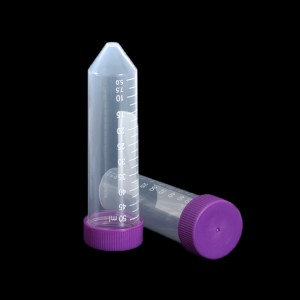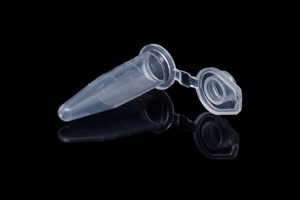Centrifuge tubes: are used to contain liquids during centrifugation, which separates the sample into its components by rapidly rotating it around a fixed axis. It is available with sealing cap or gland. It is a common experimental consumable in the laboratory.
1. According to its size
Large capacity centrifuge tube(500ml, 250ml, Normal centrifuge tube(50ml, 15ml), Micro-centrifuge tube(2ml, 1.5ml, 0.65ml, 0.2ml)
2. According to the shape of the bottom
Conical bottom centrifuge tube, flat bottom centrifuge tube, round bottom centrifuge tube
3. According to the way the lid is closed
Gland centrifuge tube: a centrifuge tube that seals with a press, commonly found in microcentrifuge tubes
Screw cap centrifuge tube: include flat caps (the top of the cap is flat) and plug caps (the top of the cap has a plug shape)
4. According to the material: plastic centrifuge tube, glass centrifuge tube, steel centrifuge tube
1) Steel centrifuge tube: The steel centrifuge tube has high strength, no deformation, heat resistance, frost resistance and chemical corrosion resistance. It is also widely used, but it should also avoid contact with strong corrosive chemicals, such as strong acid and strong alkali. Try to avoid the corrosion of these chemicals
2) Glass centrifuge tube: When using glass tubes, the centrifugal force should not be too large, and rubber pads are needed to prevent the tubes from breaking. Generally, glass tubes are not used in high-speed centrifuges. The cap of the centrifuge tube is not closed enough, and the liquid cannot be filled up (for high-speed centrifuges and angle rotors are used) to prevent overflow and loss of balance. The consequence of spillage is to pollute the rotor and the centrifugal chamber, affecting the normal operation of the sensor. During ultracentrifugation, the centrifuge tube must be filled with liquid, because ultracentrifugation requires a high vacuum, and only filling can prevent the centrifuge tube from deforming.
3) Plastic centrifuge tube: The advantage of the plastic centrifuge tube is that it is transparent or translucent, its hardness is small, and the sample can be taken out by puncture. The disadvantage is that it is easy to deform, has poor corrosion resistance to organic solvents, and has a short service life. Plastic centrifuge tubes are made of PP (polypropylene), PC (polycarbonate), PE (polyethylene) and other materials. PP pipe performance is relatively better. The plastic centrifuge tube is transparent or translucent, and the centrifugation of the sample can be seen intuitively, but it is relatively easy to deform and has poor corrosion resistance to organic solvents, so the service life is short.
The following is a brief introduction to each material:
PP(polypropylene): translucent, with good chemical and temperature stability, but it will become brittle at low temperature, so do not centrifuge below 4°C.
PC (polycarbonate): good transparency, high hardness, can be sterilized at high temperature, but not resistant to strong acid and alkali and some organic solvents such as alcohol. It is mainly used for ultra-high-speed centrifugation above 50,000 rpm.
PE (polyethylene): opaque. It does not react with acetone, acetic acid, hydrochloric acid, etc. It is relatively stable and tends to soften at high temperatures.
PA (polyamide): This material is a polymer made of PP and PE, translucent, very stable in chemical properties, but not resistant to high temperature.
PS (polystyrene): transparent, hard, stable to most aqueous solutions, but will be corroded by various organic substances, mostly used for low-speed centrifugation, and generally used for one-time use.
PF (polyfluorine): translucent, can be used at low temperature, if the experimental environment is -100 ℃ -140 ℃, you can use the centrifuge tube made of this material.
CAB (Cellulose Butyl Acetate): transparent, can be used for the gradient determination of dilute acids, alkalis, salts, alcohols, and sucrose.
Post time: Mar-22-2023





